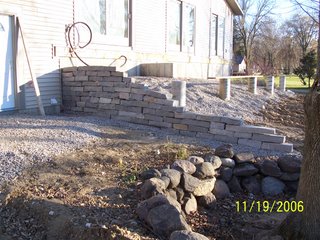



These are necessary for us to get the slope of the final grade as we desire. Stacking up these blocks is not that hard (granted, someone who knows what they're doing could probably get tighter joints, but I think these are OK). I had 4 full pallets to work from, roughtly 1 ton per pallet. I used about 3.5 pallets/7000# of stone.
The hard part is not the stone, but rather the gravel that's piled behind the walls. I had some gravel "pre-piled" by the excavator behind where the wall was to go. However, I had to move about 20 wheelbarrow loads over from the main pile. The ground was sloppy-muddy so I could not take a direct route from pile to wall. That shovelling and transporting was the hardest work of this job. There just was not enough of it to warrant a skid steer rental, but boy what I would have given to have one for just 3 or 4 trips. . . .
We have matching "thin veneer" stone that will be applied to the columns.
For the record: Any variations in wall straightness or setback angle; those aren't mistakes, that's "rustic".
4 comments:
What strength do you think there is in this wall? How much load will it be bearing?
N
I think that the strength in the wall is "sufficient". Their sole purpose so we can pitch the final grade as desired.
They are not that high and I do have them battered back quite a bit. I am backing them with gravel for better drainage and support, too.
What makes you ask?
I have just finished a retaining wall in my own yard. it is five and a half feet high but no mortar. It is three feet thick and will last forever, because the stone is properly laid. With no mortar between the stone it is freedraining. the back of the wall is full of rock which fits together as much as possible to form a solid mass of masonry. Every two feet there is a tiestone which goes from the front of the wall into the banking.
I just wondered if your one did have the strengh to hold back the banking, especially when it has to carry a load. Gravel would provide no strength, it will pour away from the pressure.
I was taught that a retaining wall should be half as wide as its height.
The building system you are using is most interesting, might use it one day.
From your description, There is no doubt that you've built a "proper" retaining wall. Mine is more decorative than structural.
Mine is probably no more tham 3-1/2 feet high. I guess time will tell if it will last. While I am hoping it does not blow out, if it does it won't be a big deal to re-set it. The loss of the wall would not effect the house in any way.
Post a Comment